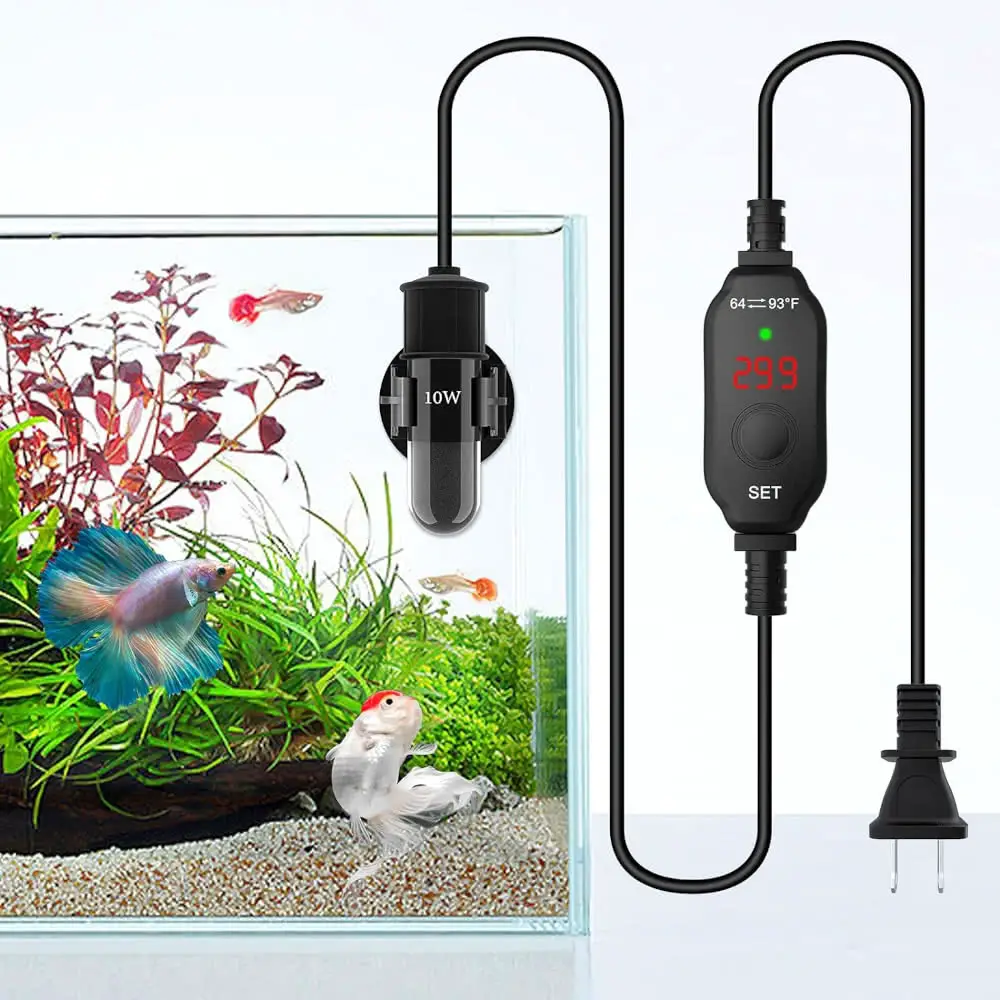Setting up a well-maintained aquarium is crucial for the health and well-being of the fish and other aquatic organisms. One of the essential components of an aquarium setup is a reliable and efficient aquarium heater. A heater ensures that the water temperature remains stable, which is vital for the survival and comfort of the aquarium’s inhabitants. However, with so many options available on the market, choosing the best aquarium heater can be quite overwhelming. In this comprehensive buying guide, we will explore the key factors and features that you should consider to make an informed decision and select the best aquarium heater for your setup.
Importance of an Aquarium Heater
Before delving into the factors to consider when purchasing an aquarium heater, let’s first understand its importance. Fish are cold-blooded animals, which means they are unable to regulate their body temperature on their own. They rely on the surrounding water temperature to maintain their internal temperature. Therefore, it is crucial to provide them with a stable and consistent environment within the aquarium.
If the water temperature fluctuates significantly or falls outside the suitable range for the fish species, it can lead to stress, weakened immune systems, and even death. Therefore, a reliable aquarium heater is a must-have equipment for any aquarist who wants to create and maintain an optimal environment for their aquatic pets.
Factors to Consider When Selecting an Aquarium Heater
To ensure you choose the best aquarium heater for your setup, it’s essential to consider several key factors. By taking these factors into account, you can ensure that the heater meets the specific needs and requirements of your aquarium and its inhabitants. Let’s explore these factors in detail.
Tank Size and Heater Power
The size of your aquarium is an important consideration when selecting an aquarium heater. The heater’s power, usually measured in watts, determines its ability to heat the water effectively. Choosing the appropriate wattage will depend on the size of your tank and the desired temperature increase.
A good rule of thumb is to provide approximately 5 watts of heating power for every gallon of water in your aquarium. For example, if you have a 20-gallon tank, you would need a heater with a minimum power rating of 100 watts.
Additionally, it’s essential to consider the ambient temperature of the room where your aquarium is located. If the room temperature is consistently colder or warmer than the desired water temperature in the tank, you may need to adjust the power rating accordingly.
Type of Heater
Aquarium heaters come in various types, each with its own set of advantages and disadvantages. Let’s explore the three main types of heaters:
Submersible Heaters
Submersible heaters are the most popular and commonly used type of aquarium heaters. These heaters are designed to be fully submerged in the water, allowing for effective and efficient heat distribution.
One of the primary advantages of submersible heaters is their ability to maintain a consistent temperature throughout the tank. They are also easy to install and come in a range of power options suitable for different tank sizes.
When choosing a submersible heater, look for a model that has a reliable thermostat to ensure accurate temperature control. It’s also important to consider the size of the heater, as larger tanks may require multiple heaters for optimal heating distribution.
Hang-On-Back (HOB) Heaters
Hang-on-back heaters, also known as HOB heaters, are designed to be attached to the back of the aquarium. These heaters utilize a heating element that is exposed to the water, allowing for efficient heat transfer.
One of the advantages of HOB heaters is that they are easy to install and do not require full submersion in the water. They also provide better accessibility for temperature adjustments and maintenance.
However, HOB heaters may not be suitable for tanks with limited space behind them, as they can protrude from the back of the tank. They are also more visible compared to submersible heaters, which may be a concern for aquarists who want a clean and unobstructed view of their aquarium.
In-Line Heaters
In-line heaters are installed in the aquarium’s filtration system, either inside the filter canister or in the return line. These heaters are ideal for larger aquariums or setups where visual aesthetics are a priority.
One of the primary advantages of in-line heaters is their ability to heat the water before it enters the tank. This ensures more efficient heat distribution throughout the entire aquarium, particularly in tanks with complex setups or larger volumes of water.
However, installing an in-line heater requires additional plumbing work and may not be suitable for all aquarium setups. They can also be more expensive compared to other types of heaters.
Depending on the specific requirements of your setup, you can choose the most suitable type of heater. Keep in mind factors such as tank size, ease of installation, and visual aesthetics when making your decision.
Heating Element and Construction
The quality and durability of the heating element and construction play a significant role in the overall performance and longevity of an aquarium heater. Here are a few factors to consider:
Material
Look for heaters with heating elements made from high-quality materials such as titanium or glass. Titanium heaters are known for their exceptional durability and resistance to corrosion. They are also more resistant to damage caused by accidental contact with rocks or other aquarium decorations.
Glass heaters, on the other hand, are a popular choice due to their affordability and reliability. However, they may be more prone to cracking or breaking, particularly if not handled with care.
Safety Features
Ensure that the heater you choose has built-in safety features to prevent accidents or damage to the aquarium and its inhabitants. Overheating protection, such as an automatic shut-off feature, is crucial to prevent the water from reaching dangerously high temperatures.
Some heaters also have protective casing or guards to shield the heating element and prevent direct contact with the fish or other aquarium inhabitants. These safety features are particularly important if you have delicate or finicky fish species that may be more susceptible to temperature fluctuations.
Temperature Range and Accuracy
Check the temperature range and accuracy of the heater before making your purchase. Different fish species have different temperature requirements, so it’s important to select a heater that can maintain the desired temperature range.
Most aquarium heaters have a temperature range between 68°F to 90°F (20°C to 32°C), which is suitable for a wide range of tropical fish species. However, if you have specific temperature requirements for your aquarium, ensure that the heater can meet those needs. It’s also important to choose a heater with an accurate thermostat to prevent temperature fluctuations.
Thermostat and Temperature Control
The thermostat is a crucial component of an aquarium heater that allows you to control and maintain the desired water temperature. Consider the following factors when evaluating the thermostat and temperature control features of a heater:
Adjustable and Accurate
Ensure that the thermostat is adjustable and provides precise temperature control. Some heaters have a simple dial or knob for temperature adjustments, while others may have digital displays or touch controls. Choose a thermostat that is easy to use and allows you to set the desired temperature with precision.
It’s also important to choose a heater with a thermostat that has a narrow temperature differential. The temperature differential refers to the difference between when the heater turns on and off to maintain the desired temperature. A smaller temperature differential ensures more accurate temperature control and minimizes temperature fluctuations within the tank.
Calibrated and Calibratable
Some high-quality aquarium heaters come pre-calibrated, meaning they have been tested to ensure accurate temperature readings. However, even pre-calibrated heaters may require occasional calibration to maintain accuracy over time.
Consider whether the heater you are interested in can be recalibrated if needed. This allows you to make adjustments if you find any discrepancies between the actual water temperature and the thermostat reading.
External Temperature Controllers
For added control and convenience, consider purchasing a heater that is compatible with an external temperature controller. External temperature controllers allow you to set precise temperature ranges and automate temperature adjustments based on specific time intervals or other parameters. This can be particularly beneficial for large or complex aquarium setups.
Ease of Installation and Maintenance
Another important factor to consider is the ease of installation and maintenance of the aquarium heater. Here are a few points to keep in mind:
Suction Cups or Mounting Options
Check for heaters that come with reliable suction cups or mounting brackets to ensure secure attachment to the aquarium glass. These mounting options should be sturdy and allow for easy installation and adjustment.
Placement Options
Consider the placement options available for the heater. Some heaters are versatile and can be placed horizontally or vertically, while others may have specific placement requirements. Choose a heater that allows for flexible placement, considering the available space and compatibility with your filter and other equipment.
Ease of Maintenance
Ensure that the heater is easy to clean and maintain. Some heaters may have removable or replaceable parts, such as the heating element or protective casing, which makes cleaning and upkeep much more convenient.
Brand Reputation and Customer Reviews
When purchasing an aquarium heater, it’s always a good idea to consider the brand reputation and customer reviews. Look for brands that are well-established and have a positive track record in the aquarium industry.
Searching for customer reviews and testimonials can provide valuable insights into the performance and reliability of the heater. Pay attention to both positive and negative reviews to get a balanced perspective on the product. Keep in mind that individual experiences may vary, but patterns in feedback can give you a sense of common issues or positive aspects of each heater.
Conclusion
Selecting the best aquarium heater for your setup is a crucial decision that can impact the health and well-being of your aquatic pets. By considering factors such as tank size, type of heater, heating element and construction, thermostat and temperature control, ease of installation and maintenance, and brand reputation, you can make an informed decision.
Remember to choose a heater that provides reliable and consistent heat distribution, has built-in safety features, and allows for accurate temperature control. Each aquarium setup is unique, so take the time to assess your specific requirements and choose a heater that is compatible with your tank size, fish species, and overall setup.
Investing in a high-quality and reliable aquarium heater will ensure that your aquatic pets live in a comfortable and optimal environment, promoting their health, happiness, and longevity.




